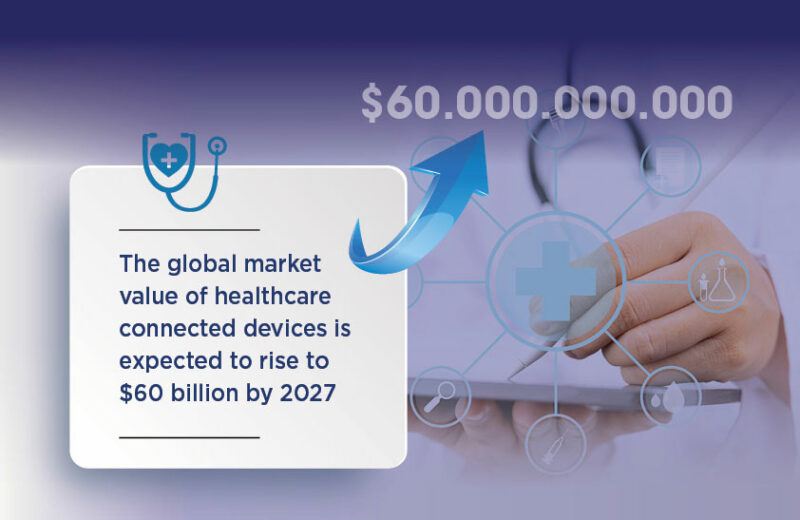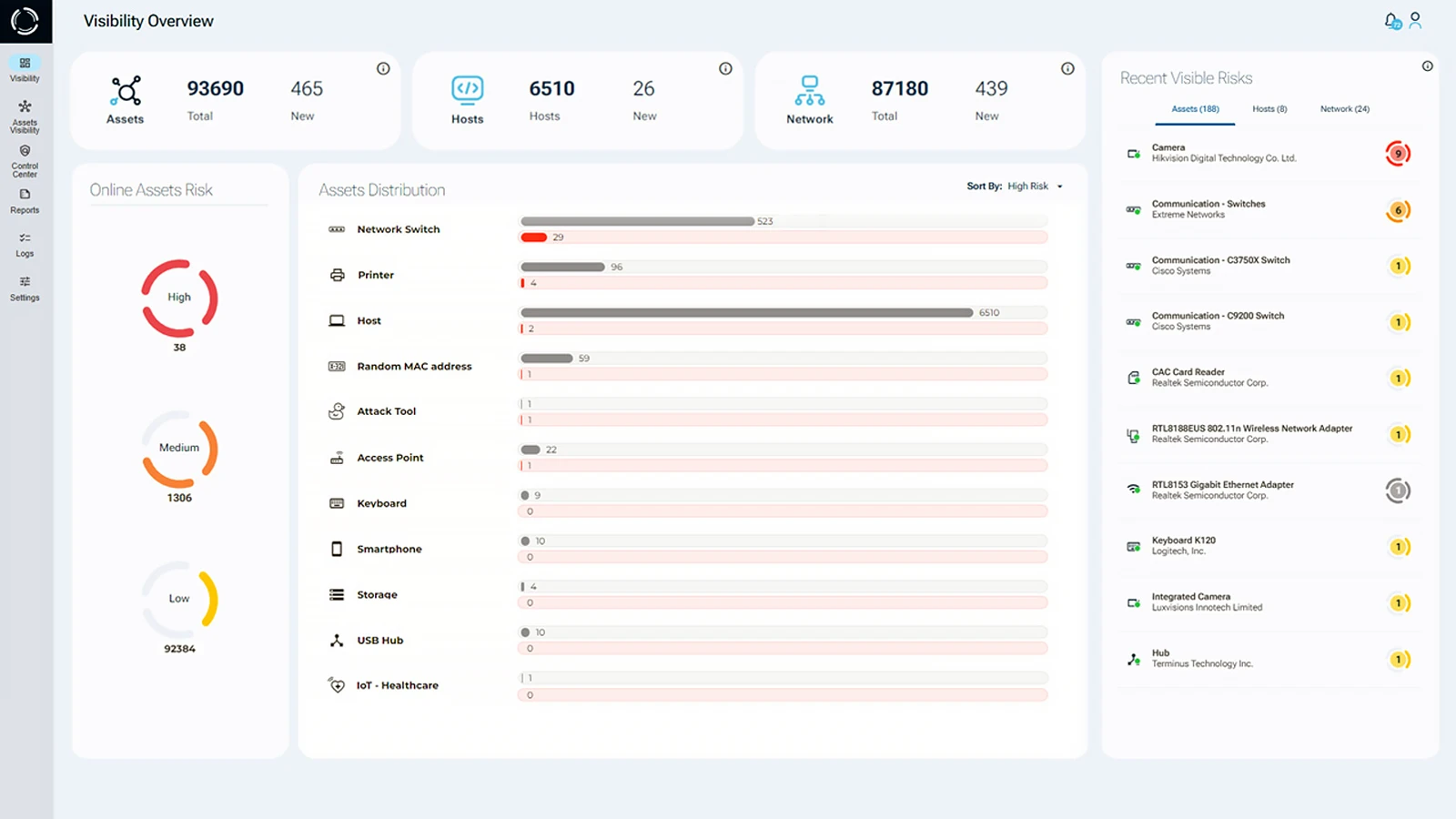Why Is Medical Device Cyber Security More Critical Than Ever?
Connected medical devices are revolutionizing healthcare by enabling real-time monitoring, diagnosis, and treatment. These devices communicate through networks to collect and transmit patient data, improving outcomes and enhancing healthcare delivery. However, the widespread use of connected medical devices has brought critical security concerns to the forefront, highlighting the need for robust connected medical device security.
With their growing prevalence, the global market for connected medical devices is projected to reach $60 billion by 2027, a significant increase from $38 billion in 2020. This growth amplifies the urgency for robust connected medical device security measures, ensuring the safety and privacy of patients’ data and the seamless functionality of these critical devices.
As more individuals rely on connected medical devices for daily health management, these devices are becoming a prime target for cyberattacks. As part of the Internet of Medical Things (IoMT), connected medical devices are highly susceptible to vulnerabilities that threaten both patient privacy and device integrity. The healthcare sector’s increasing exposure to these threats, particularly in the past year, emphasizes the critical importance of connected medical device security. It is essential to stay vigilant, understand potential threats, and implement measures to mitigate risks to ensure the safety and privacy of patient data.

Connected Medical Device Security
The Risks of Stolen Patient Data
The rise of connected medical devices, many of which lack standardized security measures, introduces varying levels of vulnerability. These devices collect and transmit sensitive patient information, which can be exploited if not properly secured.
Unauthorized entries into medical databases can be detrimental to patients as well as healthcare organizations. Such databases contain troves of sensitive information such as insurance records and financial data. A data breach is a serious violation of patient privacy that can lead to penalties, lawsuits, and other costly consequences for healthcare providers.
Healthcare Organizations also need to comply with General Data Protection Regulation (GDPR) and Health Insurance Portability and Accountability Act (HIPAA). To ensure protection of patient’s data and privacy.
Hacker-Controlled Medical Devices
Cyberattacks are a major threat to connected medical devices, allowing hackers to infiltrate and manipulate personal medical equipment. Beyond stealing patient records, cyberattacks can directly endanger patient welfare (IoMT Security). Attackers can control devices, adjusting settings or even turning them on and off, with potentially life-threatening consequences for patients who depend on these devices for everyday health support.
Disruption in Patient Care
Ransomware attacks are among the most common attacks targeting connected medical devices. Hackers use this form of cyberattack to compromise vital files and even entire systems until medical service providers pay a ransom. During the pandemic, there were instances where hackers refused to give hospitals access to crucial, life-saving files and operations until they got paid. Prioritizing connected medical device security ensures that patient welfare remains paramount in the face of evolving cyber threats.
Damage to Reputation and Credibility
Cyberattacks can severely damage the reputation and credibility of healthcare providers. Following a data breach, patients and stakeholders may lose confidence in the security of their data. Trust is a cornerstone of healthcare, and once it is lost, it can be difficult—and costly—to regain. Protecting connected medical devices not only secures patient data but also upholds the trust and integrity of the medical field.
Prioritizing robust connected medical device security is essential for protecting patient data, ensuring uninterrupted patient care, and maintaining the reputation of healthcare organizations. As cyber threats evolve, so too must the measures in place to safeguard these critical devices.
How Can Healthcare Organizations Protect Connected Medical Devices?
Connected medical devices offer significant benefits in patient care, but they also present multiple cybersecurity risks. To fully harness their potential while minimizing these risks, healthcare institutions must implement effective countermeasures through the following strategies:
Orchestrated Firmware Updates
A key advantage of connected medical devices is their ability to be regularly updated. During these firmware updates, ensure careful orchestration and that only authorized parties can make changes to the devices.
Should an update failure ensue, there must be a contingency plan in place. Either reboot the device and restart the update or replace the device altogether. Additionally, patients need clear instructions on how to configure their devices on their home network. The proper installation lets you establish an encrypted connection between the medical devices and the IoMT.
Secure Custom Software
Healthcare institutions often rely on proprietary software to manage connected medical devices. It is vital that security is embedded into every component of this software. As a result, many developers now specialize in creating secure software for healthcare applications, often through targeted training programs. This focus on secure software development has led to an increased demand for professionals skilled in safeguarding medical devices.
Additionally, users of the system, including medical staff and administrators, should undergo regular cybersecurity training. This empowers them to recognize potential vulnerabilities in the network and take proactive steps to address them before they are exploited.
Enhancing Connected Medical Device Security with Physical Layer Visibility Fingerprinting
In a network with numerous connected medical devices, some vulnerabilities may go undetected, especially when manual reporting and employee intervention are involved. This creates openings for hackers to infiltrate the system and install unauthorized devices on the network, jeopardizing security and patient data.
A proactive solution to this challenge is integrating physical layer visibility fingerprinting on each device connected to your network. This unique approach enhances connected medical device security by providing an automated and precise method for device identification and risk management.
Sepio’s Asset Risk Management
Sepio is the only company in the world offering physical layer visibility fingerprinting. Through Sepio’s Asset Risk Management (ARM), ensures that no device is left undetected. Each device is assigned a digital fingerprint, creating a more robust cybersecurity posture. Sepio effectively and automatically determines if a medical device becomes vulnerable or if unauthorized network devices and connections are linked to the network.

With Sepio’s technology, you can automatically detect and evaluate the security posture of connected medical devices. It helps you identify vulnerabilities in real-time and ensure that only trusted devices are allowed access to the network.
See Every Asset, Prioritize Risks, and Strengthen Security
Sepio’s solution offers full visibility into every known and shadow asset within your network. By prioritizing and mitigating risks effectively, Sepio enables healthcare organizations to take a proactive approach to connected medical device security.
Talk to an expert to learn how our patented technology can help you gain full control over your asset risks, ensuring a more secure and reliable network for connected medical devices






